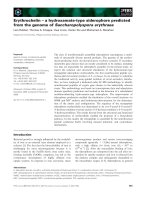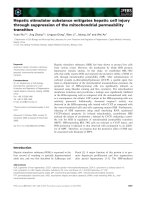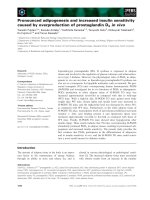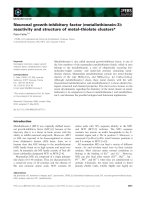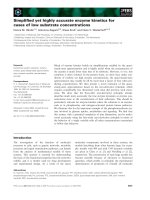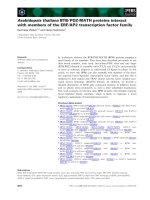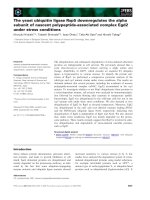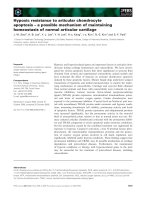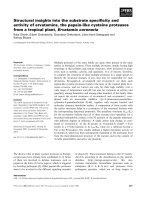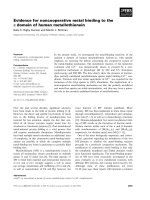báo cáo khoa học: "Bacillus Calmette-Guérin-related cold thigh abscess as an unusual cause of thigh swelling in infants following BCG vaccine administration: a case series" doc
Bạn đang xem bản rút gọn của tài liệu. Xem và tải ngay bản đầy đủ của tài liệu tại đây (272.85 KB, 4 trang )
CAS E RE P O R T Open Access
Bacillus Calmette-Guérin-related cold thigh
abscess as an unusual cause of thigh swelling in
infants following BCG vaccine administration:
a case series
Mohammad Al Namshan
1*
, Omar Oda
1
, Jameela Almaary
1
, Saud Al Jadaan
1
, Stanley Crankson
1
, Esam Al Banyan
2
,
Mohammad Al Shaalan
2
and Mohammad Zamakhshary
1
Abstract
Introduction: Thigh swelling in an infant can be a symptom of a simple benign condition or a life-threatening
condition. We observed a cluster of thigh swelling episodes in infants in which the cause was Bacillus Calmette-
Guérin-related cold thigh abscess. We report this unusual case series to raise awareness about this diagnosis.
Case presentations: We performed a retrospective review of five infants (four boys and one girl) who presented
with Bacillus Calmette-Guérin-related left thigh abscess. The swelling was noticed by the parents at a mean period
of three months prior to presentation. The ages at presentation were five, five, eight and nine months for the boys,
and six months for the girl. All of the patients were healthy Saudi infants, and received the Bacillus Calmette-
Guérin vaccine at birth. Clinically, all of the patients were well and did not demonstrate signs of systemic infection.
All patients underwent needle aspiration, with subsequent incision and drainage in four of the five cases. The
cultures obtained from the abscess fluids were the key to establishing the diagnosis. Only three patients (60%)
received antituberculosis drugs. Wound healing lasted for a mean period of approximately seven months. Two-year
follow-up was unremarkable for all of our patients.
Conclusions: Technical errors continue to be significant in the development of vaccine-related complications.
Bacillus Calmette-Guérin-related cold thigh abscess is an extremely rare entity.
Introduction
Bacillus Calmette-Guérin (BCG) vaccine is considered
one of the safest vaccines available [1,2]. Adverse reac-
tions to the BCG vaccine are not common [1-6]. Factors
that play a role in the development of vaccine-related
complications include age and immune status of the
vaccinee, route of administration and technique, and
quality, strain and dose of the BCG vaccine delivered
[1-5]. Technical factors are still considered the most sig-
nificant in the development of vaccine-related complica-
tions [1, 5]. We report five cases in which the erroneous
injection of the BCG vaccine intramuscularly into the
thigh lead to the formation of a cold thigh abscess.
Case presentations
Case 1
A six-month-old healthy Saudi girl presented with left
thigh swelling that was noticed by her parents three
months prior to presentation. The swelling slowly
increased in size. There was no history of trauma or
other illness. Our patient looked well and had normal
vital signs. A physical examination revealed a soft, fluc-
tuant, nontender left thigh lesion with no overl ying skin
changes. Laboratory tests revealed a white blood cell
(WBC) count of 21.9 ×10
9
/L. Magnetic resonance ima-
ging (MRI) of her left thigh revealed signs of hematoma.
Needle aspiration of the lesion revealed serous, light yel-
lowish fluids. Cultures of the aspirated fluids grew
* Correspondence:
1
Division of Pediatric Surgery, Department of Surgery, King Abdulaziz
Medical City, King Saud bin Abdulaziz University for Health Sciences, Riyadh,
Saudi Arabia
Full list of author information is available at the end of the article
Al Namshan et al. Journal of Medical Case Reports 2011, 5:472
/>JOURNAL OF MEDICAL
CASE REPORTS
© 2011 Al Namshan et al; licensee BioMed Cent ral Ltd. This is an Open Access article distributed under the terms of the Creative
Commons Attribution License ( which permits unrestricted use, distribution, and
reproduction in any medium, provided the original work is properly cited.
Mycobacterium bovis. Our patient was put on isoniazid
and rifa mpicin for six months by the pedi atric infectious
disease team. At the site of the needle aspiration, our
patient developed a sinus that healed within six months,
leaving a small scar. The two-year follow-up was
unremarkable.
Case 2
A five-month-old healthy Saudi boy presented with left
thigh swelling that was noticed by his parents three
months prior to presentation. There was no history of
trauma or other illne ss. Two weeks prior to presentation,
the swelling markedly increased in size, and the overlying
skin became erythematous. Our patient looked well and
had normal vital signs. A physical examination revealed a
fluctuant, nontender left thigh lesion with overlying skin
redness and no hotness. Laboratory tests revealed a WBC
count of 31.1 × 10
9
/L and an erythrocyte sedimentation
rate (ESR) of 20 mm/h. MRI of his left thigh revealed an
abscess. Needle aspiration of the lesion revealed purulent
fluids. Incision and drainage (I&D) of the abscess were
performed during the same procedure. Cultures of the
aspirated fluids grew M. bovis. Our patient was put on iso-
niazid and rifampicin for six months by the pediatric infec-
tious disease team. At the site of the I&D, our patient
developed a sinus that healed within three months, leaving
a small scar. The two-year follow-up was unremarkable.
Case 3
A five-month-old h ealthy Saudi boy presented with left
thigh swelling that was noticed by his parents three
months prior to presentation. The swelling slowly
increased in size. There was no history of trauma or
other illness. Our patient looked well and had normal
vital signs. A physical examination revealed a soft, fluc-
tuant, nontender left thigh lesion with no overlying skin
changes. Laboratory tests revealed a WBC count of 16.8
×10
9
/L and an ESR of 13 mm/h. An ultrasound of his
left thigh indicated an abscess. Needle aspiration of the
abscess revealed purulent fluids. I&D of the abscess were
performed during the same procedure. Cultures of the
aspirated fluids grew M. bovis. Our patient was put on
isoniazid and rifampicin for six months by the pediatric
infectious disease team. However, the medications were
stopped after three months because our patient devel-
oped an impaired lev el of consciousness. At the site of
the I&D, our patient developed a sinus that became
infected with Pseudomonas and required another I&D
procedure. Wound healing lasted for ten months, leaving
a small scar. The two-year follow-up was unremarkable.
Case 4
A nine-month-old healthy Saudi b oy presented with left
thigh swelling that was noticed by his parents three
months prior to presentation. The swelling slowly
increased in size. Ten days prior to presentation, the
overlying skin became erythematous, and the lesion
increased in size. There was no history of trauma or
other illness. Our patient looked well and had normal
vital signs. A physical examination revealed a fluctuant,
nontender left thigh lesion with overlying skin erythema.
Laboratory tests revealed an ESR of 55 mm/h. Needle
aspiration of the lesion revealed purulent fluids. I&D of
the abscess were performed during the same procedure.
Cultures of the aspirated fluids grew M. bovis.Our
patient did not receive antituberculosis drugs. At the
site of the I&D, our patient developed a sinus that
healed within eight months, leaving a small scar. The
two-year follow-up was unremarkable.
Case 5
An eight-month-old h ealthy Saudi boy presented with
left thigh swelling t hat was noticed by his parents four
months prior to presentation. The swelling slowly
increased in size. There was no history of trauma or
other illness. Our patient looked well and had normal
vital signs. A physical examination revealed a fluctuant,
nontender left thigh lesion with no skin changes.
Laboratory tests r evealed a WBC count of 23.8 × 10
9
/L.
Needle aspiration of the lesion revealed purulent fluids.
I&D of the abscess were performed during the same
procedure. Cultures of the aspirated fluids grew M.
bovis. Our patient did not receive antituberculosis drugs.
AtthesiteoftheI&D,ourpatientdevelopedasinus
that healed within eight months, leaving a small scar.
The two-year follow-up was unremarkable.
Discussion
Thigh swelling is a symptom of various benign and
malignant conditions [7-9]. Hematoma as a re sult of
trauma, iatrogenic in jection or coagulopathy is one of
the causative disorders. Infe ctions like cellulitis, necro-
tizing fasciitis, septic arthritis, and o steomyelitis are
other causes of thigh swelling in infants. Benign and
malignant tumors can also present as thigh swelling.
Differential diagnosis is not alw ays easy, pa rticularly if
the causative disorder has not previously been reported.
In the first case, there was no history of witnessed
trauma. The rest of the medical and family history was
also unremarkable, making the dia gnosis of hematoma
less likely. There were no general or local sign of infec -
tion. Tumor was the most likely diagnosis on physical
examination. MRI of her left thigh did not provide a
clear answer but revealed signs of hematoma and indi-
cated that needle aspiration be used for a final diagnosis.
When the cultures grew M. bovis, it became obvious
that the abscess was a complication of BCG vaccination.
However, the pat hogene sis was not clear. The ab sence
Al Namshan et al. Journal of Medical Case Reports 2011, 5:472
/>Page 2 of 4
of skin scarring in the left upper arm above the deltoid
muscle in our patients raised the possibility of inadver-
tent injection of the BCG vaccine intramuscularly into
the left thigh instead of the intradermal adm inistration
into the left upper arm. Our patient was clinically well.
However, the possibility of subclinical disseminated dis-
ease in this case and in the two subsequent cases was
the justifi cation for prescribing antituberculosis medica-
tions given by the pediatric infectious disease team.
In the rest of the cases, the possibility of a BCG-
related cold thigh abscess was considered. The cultures
of the aspirated fluids were the key to establishing the
final diagnosis.
In the Kingdom of Saudi Arabia, as per World Health
Organization recommendations, the BCG vaccine is
given to all healthy neonates [5,10]. The technique
involves the intradermal injection of 0.05 mL of the vac-
cine into the left upper arm. In our hospital, BCG vac-
cine is given to all healthy newborns three to four hours
after birth intradermall y in the left upper arm. Th e vac-
cine used is manufactured by Statens Serume Institut,
Denmark. At the same time, 0.5 mL of hepatitis B vac-
cine is injected intramuscularly in one thigh and vitamin
K into the other thigh. All these injections used to be
given by one certified nurse in the same room and at
the same time.
A review of the medical records revealed that all of
these infants were vaccinated by the same nurse, who is
certified and has experience. Investigations did not reveal
how the error occurred; however, the only reasonable
explanation is that the BCG vaccine was confused with
the hepatitis B v accine or vitamin K, and inadvertently
injected intramuscularly into the left thigh instead of an
intradermal administration into the left upper arm. The
recommendation of the infection control and patient
safety committees was to assign one nurse to give the
BCG vaccine in an assigned BCG vaccination room and
another nurse to administer the hepatitis B vaccine and
the vitamin K in a different room and at an another time.
Since that policy was implemented approximately three
years ago, we have not had any similar cases.
The BCG vaccine is administered to 100 million chil-
dren each year and is considered to be one of the safest
vaccines available [1,2]. Adverse reactions arising from
the use of BCG vaccine in healthy infants are relatively
uncommon [1-6]. Local and regional adverse reac tions
to BCG vaccinations include local swelling, abscess for-
mation, ulceration, keloid formation and regional lym-
phadenitis. Such reactions occur at a rate of four-30 per
1000 vaccinated infants and comprise the majority
(84%) of adverse reactions reported [1,4]. Local and
region al adverse reactions are generally self-limiting and
require no treatment [2,3]. Systemic adverse reactions to
the BCG vaccine are rare and include osteomyelitis and
disseminated BCG infection [1,4]. Disseminated BCG
infection has been estimated to occur at a rate of 0.19-
1.56 per million vaccinees and is associated with a high
case fatality ratio of 80-83%. Disseminated BCG infec-
tion has almo st exclusively occurred in individuals with
severely compromised cellular immunity. However, it
also has also been reported in healthy immunocompe-
tent infants [5]. Vaccine-induced extensive ulcerating
vasculitis is also an extremely rare systemic adverse
reaction to the BCG vaccine [6].
The considerable variation in the number of adverse
reaction reports from different countries is thought to
be due to a number of factors, including the level of
case finding and the diagnostic criteria employed, the
route of administration and technique, the age and
immune status of the vaccinees and the quality, strain
and dose of the BCG vaccine de livered [1-5]. Many
reports have stressed the importance of technical factors
[1,5]. One of these technical errors is subcutaneous
administration of the BCG vaccine, which can result in
localized abscess formation. Other technical issues
involve incorrect reconstitution of the vaccine, incorrect
selectionofsyringesandtheuseofthesamesyringeto
vaccinate several children, leading to errors in dose.
To the best of our knowledge, BCG-related cold thigh
abscess has not previously been reported in the English
literature. In our case series, the only reasonable expla-
nation for the phenomenon observed is the confusion of
the BCG vaccine for t he hepatitis B vaccine and/or vita-
min K, and the inadvertent injection of the BCG vaccine
intramuscularly into the thigh by the vaccinating nurse.
The number of newborns that received the BCG vaccine
intramuscularly into the thigh is unknown. It is also
unknown how many of them developed local reactions
and h ow many were treated at other centers. It is also
unclear whether other factors, such as age of the vacci-
nees or the quality of the vaccine strain, played a role in
abscess formation in our patients. Nevertheless, we
think that t he technical error of confusing the vaccines
and administering the BCG vaccine intramuscularly
played the main role in our reported cases.
Conclusions
Correct vaccination techniques remain the most impor-
tant factor in the prevention of vaccine-related compli-
cations. Different vaccines should not be given
simultaneously by the same nurse in the same room.
BCG-related cold thigh abscess as a result of erroneous
administration of the BCG vaccine intramuscularly into
the thigh is an extremely rare occurrence.
Consent
Written informed consents were obtained from the par-
ents of our patients for publication of this case series.
Al Namshan et al. Journal of Medical Case Reports 2011, 5:472
/>Page 3 of 4
Copies of the written consents a re available for review
by the Editor-in-Chief of this journal.
Author details
1
Division of Pediatric Surgery, Department of Surgery, King Abdulaziz
Medical City, King Saud bin Abdulaziz University for Health Sciences, Riyadh,
Saudi Arabia.
2
Division of Pediatric Infectious Diseases, Department of
Pediatrics, King Abdulaziz Medical City, King Saud bin Abdulaziz University
for Health Sciences, Riyadh, Saudi Arabia.
Authors’ contributions
OO and JA analyzed and interpreted the patient data. SJ, SC, EB, MS, and
MZ were major contributors in writing the manuscript. All authors read and
approved the final manuscript.
Competing interests
The authors declare that they have no competing interests.
Received: 25 May 2011 Accepted: 22 September 2011
Published: 22 September 2011
References
1. Murphy D, Corner LAL, Gormley E: Adverse reactions to Mycobacterium
bovis bacilli Calmette-Guerin (BCG) vaccination against tuberculosis in
humans, veterinary animals and wildlife species. Tuberculosis 2008,
88(4):344-357.
2. Goraya JS, Virdi VS: Bacille Calmette-Guerin lymphadenitis. Postgrad Med J
2002, 78(920):327-329.
3. Banani SA, Alborzi A: Needle aspiration for suppurative post-BCG adenitis.
Arch Dis Child 1994, 71(5):446-447.
4. Deeks SL, Clark M, Scheifele DW, Law BJ, Dawar M, Ahmadipour N,
Walop W, Ellis CE, King A: Serious adverse events associated with bacille
Calmette-Guerin vaccine in Canada. Pediatr Infect Dis J 2005,
24(6):538-541.
5. Thamthitiwat S, Marin N, Baggett HC, Peruski LF, Kiatkulwiwat W,
Panumatrasmee V, Varma JK, Nateniyom S, Akarasewi P, Maloney SA:
Mycobacterium bovis (Bacille Calmette-Guerin) bacteremia in
immunocompetent neonates following vaccination. Vaccine 2011,
29(9):1727-1730.
6. Ghattaura A, Eley KA, Molenaar E, Smith G: A case of ulcerating vasculitis
following a BCG vaccination. J Plas Reconstr Aesthet Surg 2007, 62(8):
e286-289.
7. Morita M, Nakamura H, Kitano T: Comparison of clinical outcome after
treatment of hip arthritis caused by MRSA with that caused by non-
MRSA in infants. J Pediatr Orthop B 2009, 18(1):1-5.
8. Mognato G, Cecchetto G, Carli M, Talenti E, d’Amore ES, Pederzini F,
Guglielmi M: Is surgical treatment of lipoblastoma always necessary? J
Pediatr Surg 2000, 35(10):1511-1513.
9. Teo HE, Peh WC: A 7-week-old female infant with a left thigh swelling.
Am J Orthop 2003, 32(10):513-515.
10. Hussey G, Hawkridge T, Hanekom W: Childhood tuberculosis: old and new
vaccines. Pediatr Respir Rev 2007, 8(2):148-154.
doi:10.1186/1752-1947-5-472
Cite this article as: Al Namshan et al.: Bacillus Calmette-Guérin-related
cold thigh abscess as an unusual cause of thigh swelling in infants
following BCG vaccine administration: a case series. Journal of Medical
Case Reports 2011 5:472.
Submit your next manuscript to BioMed Central
and take full advantage of:
• Convenient online submission
• Thorough peer review
• No space constraints or color figure charges
• Immediate publication on acceptance
• Inclusion in PubMed, CAS, Scopus and Google Scholar
• Research which is freely available for redistribution
Submit your manuscript at
www.biomedcentral.com/submit
Al Namshan et al. Journal of Medical Case Reports 2011, 5:472
/>Page 4 of 4
